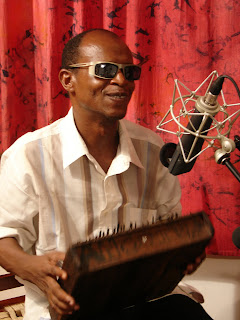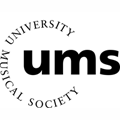Last Wednesday was quite a night to remember, as Bela Fleck brought the sound of Africa to Ann Arbor with his Africa Project, in which he traced the roots of the banjo. He brought different groups from Africa, each representing a form of music or playing musical instruments that influenced the creation of the banjo.
I was working and thus stepped into Hill after the concert had begun. Upon entering, I heard the virtuosic sound of Anania Ngoliga playing the ilimba, which is a type of thumb piano. I didn't realize until he was walking off stage, that he was blind! A friend of mine later referred to as "the Ray Charles of thumb piano," a great description!
After Ngoliga's performance, we switched gears as Bassekou Kouyate, one of the masters of ngoni, stepped on stage. Kouyate and his band, many of whom are family members, played all 4 types of the ngoni, which is a stringed banjo or guitar like instrument. At the Arts and Eats event prior to the performance, the guest speaker compared the ngoni to the saxophone family, with an alto, tenor and bass.
Kouyate played "the soprano" version, as he led the group like a rock star, with his leg rested the amp, strumming virtuosic melodies even Zeppelin would be jealous of. The atmosphere of Hill during the performance was much more like that of a rock concert than of a classic world music concert, with high energy and lots of laughs.
The rest of the concert consisted of a blending of the many different styles of music we heard that night. An impressive and once in a lifetime kind of show.
But the performance wasn't the only thing UMS had going on that night. It was also the kickoff event to our new website, umsLOBBY.org, which takes the best parts of Facebook, Twitter, YouTube and Blogs and brings them together to create a social media hub all about the art and culture of UMS. And the whole idea is simply to get people to talk. In addition to the online portion of umsLOBBY, we will have events like the one at Bela Fleck, where we simply want to get people to talk about what they are experiencing.
If you were at the concert, you may have seen the walking highlighters, decked out in green and orange, all of whom were all members of UMS staff team. As one of those highlighters, I wandered the crowds chatting with people about what brought them to the concert, their expectations and their experience. When talking to one group of students, they told me they only came because their friend had tickets and couldn't use them, so they were free and had no idea what to expect. Another group of students overheard them say that, so jumped into our conversation and told them all about Bela Fleck and the Africa Project. A much more knowledgeable bunch than I, I simply listened and learned. That experience was the epitome of umsLOBBY, turning this performance into a social experience as well as a cultural one and into one heck of a Wednesday night.
Wednesday, February 24, 2010
Monday, February 15, 2010
Luciana Souza with Romero Lubambo and Cyro Baptista

A performance by Luciana Souza with Romero Lubambo and Cyro Baptista
written by a member of the University Musical Society Student Advisory Committee
While some, such as the critic John Kelman, have characterized her singing style as "new bossa nova", Souza also regaled the audience with a few old and classic bossa nova standards. The ones that I think I recognized (although I am not completely sure) were Dindi and Águas de Março ("Waters of March"). Mostly, however, she engaged in a delectable and playful musical conversation with Lubambo and Baptista.
A description of the evening will not be complete without a few special words about Baptista, whom Relix Magazine has described as possessed of an "unbridled imagination, intense musical knowledge, skill and lust for sheer joy". Playing instruments that belong to the traditional drum set, as well as what looked to be traditional Brazilian percussion instruments (including gourds), and in addition playing bizarre-looking instruments that seemed to have stepped out of the imaginarium of a febrile musical genius, Baptista engaged in some intense percussion, smiling and thrusting his salt-and-pepper beard to and fro, looking somewhat like a mad scientist let loose in a music-maker's workshop.
Sunday, February 07, 2010
A jazz performance by The Bad Plus
written by a member of the University Musical Society Student Advisory Committee
The Bad Plus actually presented two separate concerts on Friday February 5, both at the Lydia Mendelssohn Theater in the Michigan League. I attended the second of the two concerts. From friends who had attended the first concert, I heard that they had played arrangements of pop songs (something which they are famous for) in that concert, while in the later (9:30 pm) concert, which I attended, they played mostly their own compositions.
In his book The Jazz Book: From Ragtime to Fusion and Beyond, the critic Joachim-Ernst Berendt writes that piano trios tend to come in two different flavors. Some piano trios are what Berendt calls "conversational" trios: the musical model in such a piano trio is that of a musical dialogue between the pianist, percussionist and bass player, with each taking turns to solo and respond to the other two. The other model of the piano trio is what Berendt calls the "power" trio, in which the three musicians are more invested in playing music simultaneously, creating a convergence of sound, rather than in taking turns solo-ing. The Bad Plus proved to be solidly in the "power trio" tradition, with its three musicians -- Ethan Iverson on piano, Reid Anderson on bass and Dave King on drums -- playing mostly together and feeding off each other's musical energy. It was a measure of how enthused the audience was by the musical fireworks, that it stood on its feet applauding rapturously with such intensity that The Bad Plus returned on stage to give not just one but multiple encores.
Finally, I have a suggestion for UMS. I think that the decision to have this performance at the Lydia Mendelssohn Theater was an excellent one. The Mendelssohn Theater is ideally suited for intimate and edgy performances of this nature -- just as it was for the UMS performance by another edgy, avant-garde band, eighth blackbird, a couple of years ago. (I had written about that performance, too.) However, I think that the location of the University Museum of Art Commons for the educational events associated with the performance is not a good choice. This is the second UMS educational event at the UMMA Commons that I went to -- the other one was in connection with the Bill T. Jones performance -- and I had the same thoughts on both occasions. Firstly, the UMMA Commons space is too small. On both the two UMS educational/pre-performance events that I attended there, there were more people than the space could accommodate. If you must have the educational events there, perhaps you could at least get rid of the tables among the audience in the room, which just take up space and perform no useful function during the pre-performance event. Without the tables, you could accommodate more people in the room. Also, the chairs in the UMMA Commons make too much noise every time someone drags them -- it is very distracting. It would be nice to have the educational/pre-performance events at a less noisy space.
Monday, February 01, 2010
Ladysmith Black Mambazo
After 50 years of singing, Ladysmith Black Mambazo has lost none of what made them so famous to begin with. While I'm don't feel particularly enlightened about South African culture, I did enjoy myself immensely. These men have rich voices and create beautiful harmonies that carry you right into the music.

For the duration of the concert I felt as if I was part of the rhythm and part of their family. Their dancing did not feel choreographed, but like a physical manifestation of their sheer pleasure of being. Their songs were inviting and joyful, and whether the song was about hope or homelessness, the theme of togetherness remained a constant. I left the concert revitalized and content with the world.
By: Molly Baumkel
UMS Student Advisory Committee Member

For the duration of the concert I felt as if I was part of the rhythm and part of their family. Their dancing did not feel choreographed, but like a physical manifestation of their sheer pleasure of being. Their songs were inviting and joyful, and whether the song was about hope or homelessness, the theme of togetherness remained a constant. I left the concert revitalized and content with the world.
By: Molly Baumkel
UMS Student Advisory Committee Member
Subscribe to:
Posts (Atom)




